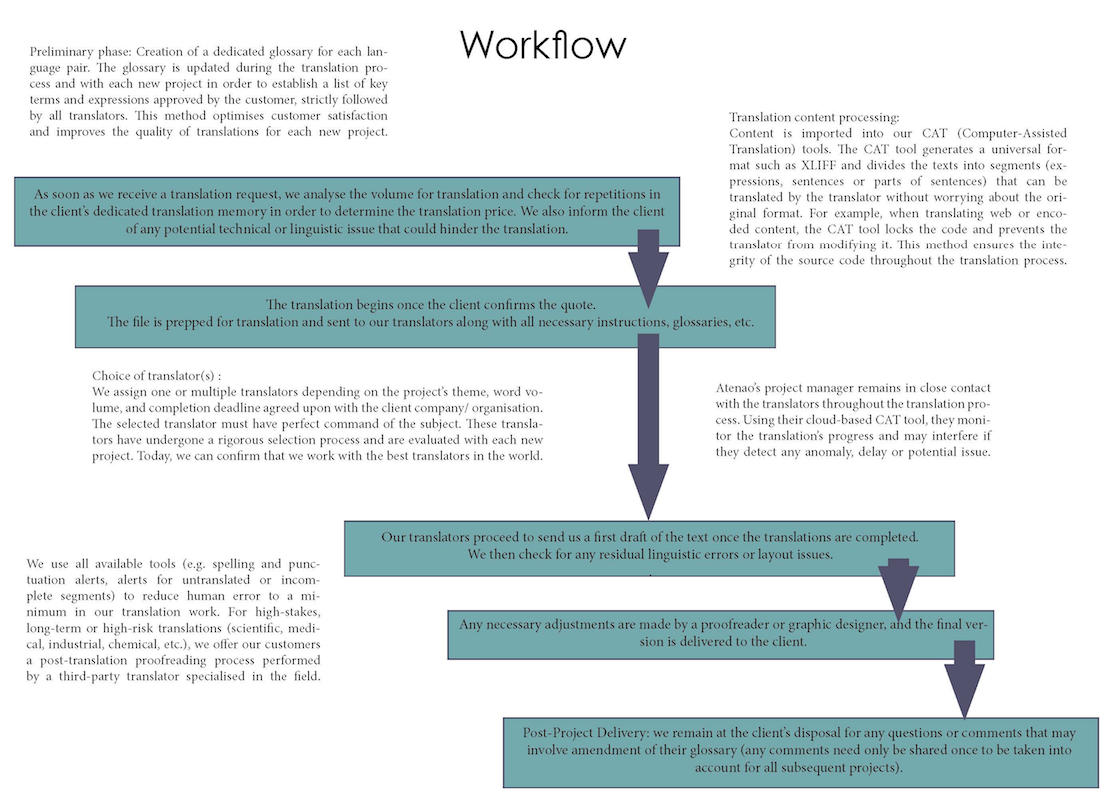Translation Workflow
In order to translate your documents, we follow a disciplined translation workflow to offer you an optimized final document that perfectly meets your standards and requirements:
The 6 steps of a tried and tested translation workflow
Preliminary phase: Creation of a dedicated glossary for each language combination. The glossary is supplied throughout the translation process and with every new project in order to establish a comprehensive list of key words and expressions validated by the client to which all translators will adhere.
- Analysis: As soon as we receive a translation request, we analyze the number of “new” and “repeated” words to translate and put together a quote. We notify the client of any potential technical or linguistic issue that may hinder the translation. Lastly, we suggest to the client, depending on the content, the most suitable type of translation for their project from the pre-determined 4 levels of translation:
- Level 4: Post-editing
- Level 3: 100% Human translation
- Level 2: ISO 17100 translation
- Level 1: “Transcreation”
- Content management and processing: content is imported into our CAT tools capable of generating a universal file format (.XLIFF) and structuring the texts into segments without having the translator worry about the initial file format which will be locked and kept separately.
- Translator selection process: We assign 1 translator or a team of translators depending on project thematic, deadline and volume. The key factor here is that the assigned translator must have a perfect grasp of the subject in question. These very translators are selected through a draconian process and are evaluated with every new project.
- Translation: The project manager at Atenao remains in close contact with the translator for the duration of the translation process. They oversee, through their cloud-based CAT tool, the translation progress and may intervene and take the lead on the project in the occurrence of any anomalies, delays or any other potential issue.
- Proofreading and editing: Once the translation is finished, the initial draft is inspected. A proofreader or graphic designer will implement necessary modifications before the finalized version is submitted to the client. At Atenao, we use every available resource in order to minimize the probability of human error within our workflow such as spellcheck, punctuation and missing/ incomplete segments alerts. For high stakes translations (scientific, medical, industrial or chemical translation, etc.) we recommend and sometimes impose the Level 2: ISO 17100 certified translation service. ISO standards require a professional third-party post-translation proofreading and revision process.
- Post Delivery: We remain at the client’s disposal for an inquiry or comment they may have regarding necessary modifications to the translation or glossary (any and all comments will be taken into account for all upcoming projects).

Reporting Methodology: Gathering qualitative and quantitative data
- CAT Tool Report: after each translation, the CAT tool provides and compiles quantitative data related to the project (process duration, number of “new” or unique and repeated words, segment summary, glossary data (used/ not-used, corrected/ updated).
- Project Manager Report: Quality check for coherence between the source version and the translated version, formatting conformity, layout and integrity of the original segmentation.
- Client Satisfaction Survey: beginning with the 1st project, and then twice a year, each client is invited to evaluate project manager performance and our agency services via an online client satisfaction survey.
- Evaluation: After each project, every translator will receive either a positive, negative or neutral evaluation resulting in either their promotion through our translator hierarchy or their dismissal.
- Quality Department: Atenao’s quality control department analyses, compiles and interprets the different reports and relays the results to the project manager, the translators and Atenao’s management.






